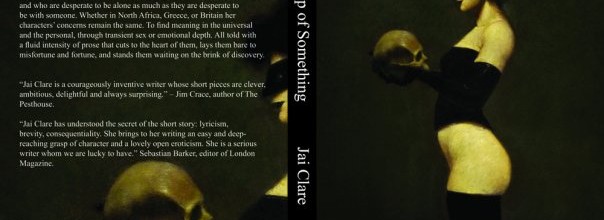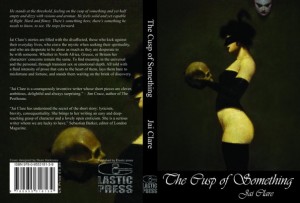
 Review: Jai Clare – The Cusp of Something
Review: Jai Clare – The Cusp of Something
Jai Clare’s collection, The Cusp of Something, is a rich work, and challenging. There’s a trend at present to only publish short story collections that have a thematic (ie Jhumpa Lahiri) or chronological link. Elastic Press has bucked this trend for several years, and this is the second time I’ve reviewed an SSC of theirs: it’s a consistently maverick approach which I hope is winning them readers, as it offers a much more demanding and powerful range of writing than one finds in some other collections.
Jai’s stories are elusive – the ‘cusp’ of the title could stand as a signifier for much of what she writes. Her characters are often fragmented, sliding between real existence and a fantasy life in which they re-present or re-create their own reality through a variety of devices: vision, memory, fantasy. And it’s not that their own realities are particularly mundane: simply that they can see, on the horizon or cusp or fracture, an alternate reality which both calls to them and frightens them – a new way of seeing the world which requires them make a leap, not so much of faith, as of imagination.
It is in part this aspect of her work that makes Jai a difficult writer to review: there is no coherent world view that shapes the vision of her characters and thus no particular agenda or perspective that makes the stories homogenous. From the intensity of Delany Wears a Hat through to the disaffected narrator of Ramblista, who reports with affection, but also exhaustion, on experiencing lives he could never hope to share, the stories range through history and reality, fantasy and sexuality, presenting each vision of the world through a (more or less) distorting lens of ‘voice’ that requires the reader to apply intelligence to the prospect of qualifying the picture presented to them. The language is a vital component of each vision, and Jai’s strong and often urgent use of internal imagery gives the reader a key to the nature of each story. This is not fiction for the lazy, but it amply repays the reader who is willing to commit to immersion in each story without prejudgement.
I wanted to talk to Jai particularly about the process of putting together a collection, so I set about exploring how a writer undertakes this exacting task:
1. You’re well known for your short stories, but how did you sort through the many you’ve written to pick the ones in The Cusp of Something. They aren’t thematically linked (although there are themes) so what criteria did you use?
I picked stories that in my opinion (though not in everyone’s) that I thought were the best stories. Also I think the collection does have some linked themes. I tried to put stories going from positive to less so with a culmination of effect at the end where the girl is left alone.
2. Did you have a target readership in mind?
No not really. I just hope people like what I do.
2.a How did it work with Elastic Press, which has published quite an eclectic collection of collections: what made them right for you and you for them?
What made me right for Elastic? They like good writing. They saw I had a good reputation and credits in the small press which says something of quality to them, I think. Also the stories aren’t straight lit fiction – there is an edge of strangeness to them. I would say I was not a realist nor a magic realist nor a SF writer or a fantasy writer. Perhaps a fabulist in the broadest sense of the term. I dunno. I don’t know what I am. A mixture of all perhaps.
3. I was around when you were choosing a cover, please tell the story of the first and eventual choices as it’s exactly the kind of serendipity every writer hopes for.
I picked a cover that I liked a lot – that was a fantasy scene which also had a mis en scene element to it which indicated both the word cusp and looking in on things happening. We were happy with this and the artist was too but as the date got closer we didn’t hear from her any further so I began to look around. I looked on sites that had lost of surrealistic work. Modern but surreal. I found this wonderful painting by Ray Donley. Soon as I saw it, it leaped out at me and I was so happy with it and therefore overjoyed when Ray generously allowed us to use it
4. You’re what is rather peculiarly termed a ‘non-traditional’ writer. Many reviewers seem to have a tick list on which they base their reviews and I would have thought that more experimental writers would be poorly served by that approach. Is it more difficult for mainstream reviewers to come to terms with your work?
Well I don’t truly think of myself as experimental. 20 years ago I would not at all be considered such but then more experimental work was carried in under the umbrella of mainstream back then. Look at Deborah Levy! So I suggest that publishing has narrowed what it will consider these days and such I find myself out on the edges – neither experimental or traditional. But yes your point is a good one. Reviewers do have a formulaic approach in what they expect all stories should be like. It’s very frustrating. Why do they expect everyone to do variants of the same? I don’t know! Judge it on what it does not on what it doesn’t even try to do!
5. What advice would you give somebody who is thinking of publishing a collection?
I never expected to get a collection out before a novel so this to me is a wonderful bonus. So I’d say never give up hope. Just don’t necessarily expect anyone to notice what you do.
6. Does teaching affect the way you write, and does writing affect the way you teach?
It feeds. But on the whole teaching stops me writing mainly ‘cos of time and so much admin to do
8. If you were abandoned on a desert island, with just one book for company, what would it be?
Ooh. Has to be the Alexandria Quartet by Lawrence Durrell. Complex interwoven beautifully written, always new things to find and beautiful words to contemplate. Anyone who knows me knows I am mad about this book. It is so unfashionable these days! Most people find it too rich. Sometimes I am not in the mood to read it but it soon takes me over as I let it. Everyone should read it
(P.S. I knew what Jai would pick: it’s a book we both love and for the first time in interviewing many writers I was absolutely confident that I could predict her choice. And if it is truly unfashionable, then fashion should change to accommodate it!)


Recent Comments